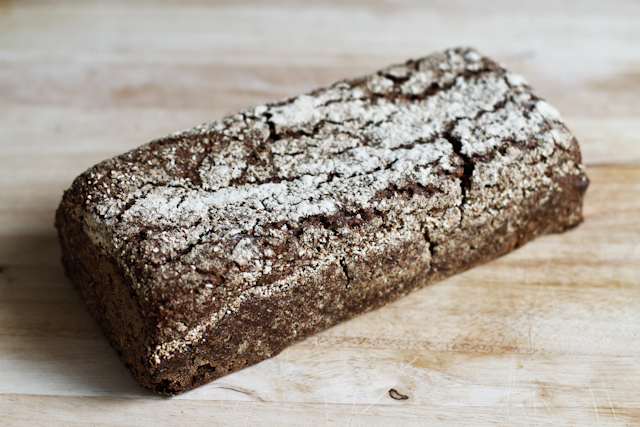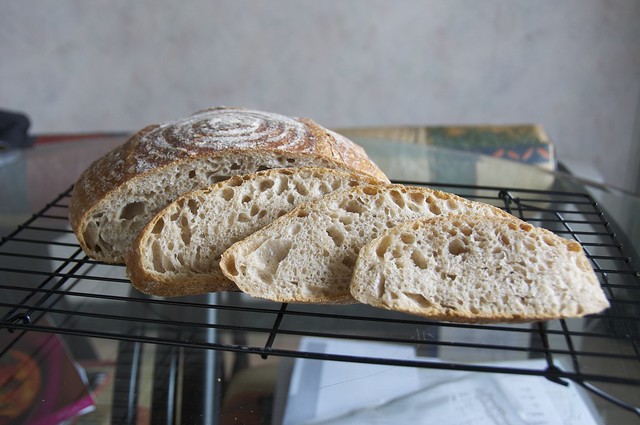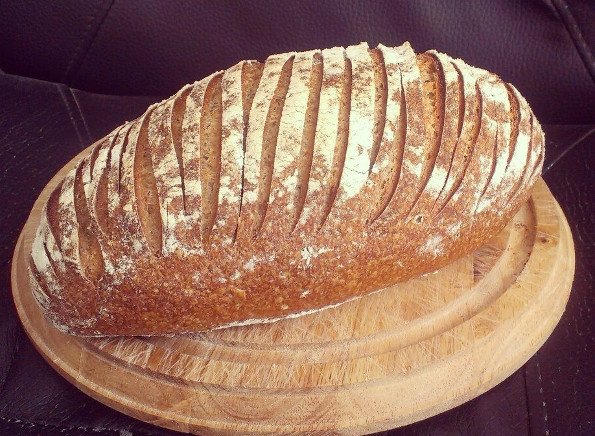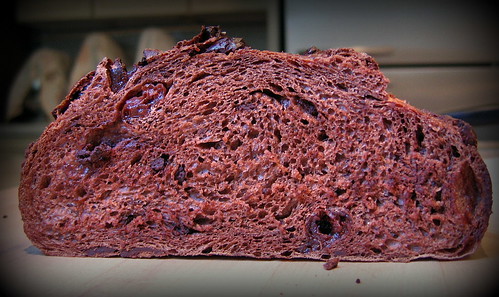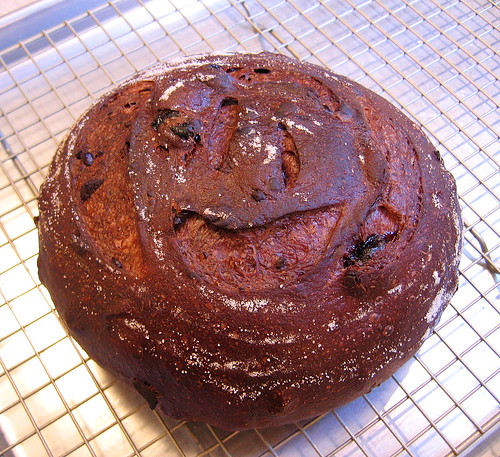
Leader's Polish Cottage Rye

Between wanting a break from my GF experiments and my starter requiring a refresh, it was time to bake something different, something with sourdough. For reasons not entirely clear to me, I keep going back to Leader's Local Breads in spite of its known defects. It probably has something to do with the fact that the breads, when they work, are just so good.
A case in point would be the Polish Cottage Rye. It's the very last formula in the book and it has no errors. Moreover, it is a very pretty and tasty bread. At 1215g, unbaked, it is also a hefty loaf but not in any way a brick. I'm getting ahead of myself...
Since I had Friday off, one of my morning tasks was to pull the starter out of the refrigerator and give it a good feeding. Thinking that rye flour might be a good pick-me-up for the starter, I used the whole rye flour that I had on hand. At that point, there was no plan for a specific bread, just getting the starter back in fighting trim was the primary goal. Even though the kitchen temperature is in the 75-78F range these days, the starter was a bit sluggish from it's 2-3 week stay in the refrigerator. It was midafternoon before the starter showed real evidence of activity and late in the evening before it was ready to launch a levain. By then, it had more than doubled (with rye flour, remember) and was eager for more food.
Since there was only finely milled whole rye flour on hand instead of the white rye that Leader calls for, that was what went into the levain build. After a thorough mixing of the starter, water, and rye flour, the levain was covered and left to its own devices through the night.
It was about 7:45 Saturday morning when I walked into the kitchen and found a levain that was ready for bread. All that was left was to combine the levain, water, bread flour, and salt into the final dough and give it a good knead. About 15-18 minutes of kneading, according to Leader. So I set to with vigor, using the slap and fold method because of the dough's relative softness. There were a couple of intervals where I used the traditional push-turn-fold method of kneading but I found myself adding more flour than I wished to because of the dough's stickiness, so then it was back to the slap and fold method.
Per Leader's directions, the dough was set to ferment until it had expanded about 1.5 times its original volume. I suspect mine was somewhat closer to doubled but without any adverse effects. The dough was then shaped into a single round and placed in a floured banneton for the final fermentation. While the loaf was fermenting, the oven was set up with a baking stone and a steam pan.
When the loaf was nearly doubled, the oven was switched on. After it had preheated to 450F, boiling water was poured into the steam pan. The loaf was immediately tipped out onto parchment paper, slashed, and slid onto the baking stone. The loaf looked well proofed before going into the oven. Once there, though, it experienced even more expansion; perhaps less than doubling but certainly a 1.5 expansion from the pre-bake size.
The fragrance while baking was wonderful. Lots of roasty/toasty notes with sourdough highlights.
We had to leave as soon as the bread came out of the oven, so I simply plopped it on a cooling rack with a towel over it. When we returned home, we found that it had been singing during our time away:

Quite a bit, actually.

That second picture also gives a sense of the amount of oven spring. You can see how there was some tearing at the intersection of two slashes on the right-hand side. It's also evident when looking at the top of the loaf:

The deep chestnut tone of the crust is just as appealing to the tongue as it is to the eye; lots and lots of malty and nutty flavors.
Given the length of the kneading, it's no surprise that the crumb is very regular and rather finely textured:

Some of the crumb texture may also be attributable to the use of whole rye, rather than white rye, flour. Since I made no adjustments in the formula's hydration, the perceived hydration may be lower than it would otherwise be.
This is a very satisfying medium rye, at least in this incarnation with whole rye flour. With white rye flour, it would no doubt be an equally satisfying light rye bread. The flavor is a delightful combination of rye and wheat, with the additional richness of the sourdough flavors. Neither seeds nor bread spice are needed in this bread; it is complete as is.
If you have, or can obtain, a copy of Local Breads, I heartily commend this bread to you.
Paul





